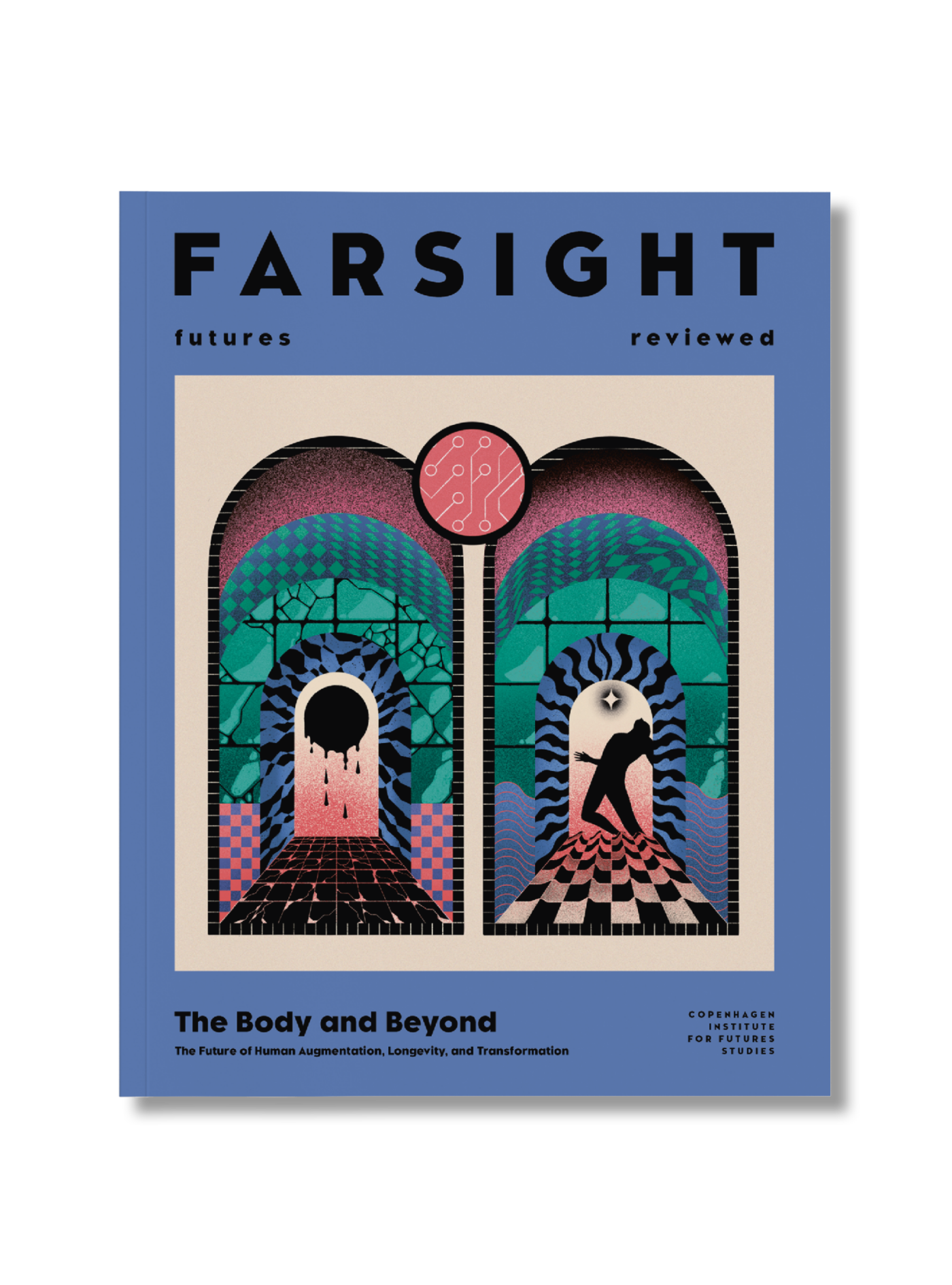
In turn, we use cookies to measure and obtain statistical data about the navigation of the users. You can configure and accept the use of the cookies, and modify your consent options, at any time.

The rich, willing, and techno-optimistic are spending fortunes optimising their biological functions to perpetuate youth. Biohacking, once described as ‘garage transhumanism’, has more than left the garage.
Illustration: Sophia Prieto
In the first half of the 20th century, the American computer scientist and philosopher, Norbert Wiener, established a theory of cybernetics – a view of control and communication feedback loops between ‘living’ and machine systems, and their environments. The conception of animal bodies as living, biological circuitry became a hugely influential idea. Cybernetics became a crossdisciplinary method of analysis for not only engineering systems, but for the idea of the human body as a machine. As foreseen by Mary Shelley in Frankenstein, the age of the cyborg was here.
The decades of rapid technological advancement that followed elevated our understanding of computer systems, and our own biology, to new levels. And alongside this new culture of computing inevitably came those who wanted to test these systems to their limits and search for ways to exploit them: hackers. The rise of hacking culture in Silicon Valley eventually intercepted with cybernetic theory, and biohacking – adapting, modifying, and transcending the human body through science and technology – was born.

Broaden your horizons with a Futures Membership. Stay updated on key trends and developments through receiving quarterly issues of FARSIGHT, live Futures Seminars with futurists, training, and discounts on our courses.
become a futures memberDid you drink coffee this morning? Perhaps you’ve tried intermittent fasting. Congratulations – you’re a biohacker. Hacking ‘living’ systems encompasses a spectrum of activities. At one end, you have the ingestible, the biologics and nutrigenomics: supplements, GMOs, nootropics and injectable human cellular material, like mRNA. There are wearables and diagnostics – smartwatches, blood testing, light therapy – and BDNF (Brain-Derived Neurotrophic Factors), brain treatments that promote neurogenesis and neuroplasticity. Taking supplements and measuring your own metrics are practices that, at least to some extent, are familiar to the general public.
At the furthest end of the spectrum are those who call themselves ‘grinders’, cyberpunk-esque self-experimentalists who inject, implant, and explore beyond regulations, and who consider themselves ‘ahead of the medicine’. Today there’s a global community of individuals who, through DIY magnetic implants built in basements and garages, can ‘sense’ mild electromagnetic fields, and pick up paperclips with one finger. Grouping the broad spectrum of biohacking under one singular term risks obfuscating its many different manifestations. What’s common for all of them, however, is the fundamental change that the data age is bringing.
Data is the language of computers, and today, computers are almost infinitely malleable. The human body is no longer a mystery; with the new availability of genomic sequencing and advancements in biomedicine, we have never known more about ourselves. But data necessitates data infrastructure, and infrastructure is inevitably centralised, managed, and owned by someone.
The balance of power when it comes to biohacking has shifted, and while diluted forms like nootropics, supplements, and smartwatches are available to most of the population, the frontier remains in the hands of a very narrow demographic: the rich, willing, and techno-optimistic.
The most prominent biohackers today – tech CEOs like Bryan Johnson, who publicly releases data on almost every conceivable aspect of his body, and is spending around $2 million a year to reverse his biological age – are flavoured with the spirit of the new Silicon Valley. As the power and wealth of the tech industry has grown, biohacking, which was initially described as ‘garage transhumanism’, has more than left the garage.
When thinking about the future of biohacking, there are perhaps some easy predictions to make. It gets better – it becomes safer, more efficient, more effective, more available, more adopted. Perhaps some things that we’ve been working towards for a long time – longevity, enhanced intelligence, highly sophisticated brain-computer interfaces (BCIs), increased wellness – will be realised.
But cybernetics is also concerned with the nature of feedback loops between a system and its environment. And our environment is quickly changing. Our phones are disrupting social patterns and shifting traditional balances of power. Blue light is disrupting circadian rhythms. We are less active. We are more isolated. Across the world, the ecological effects of technological advancements are being felt, and will only be felt harder in the decades to come.
The real test of biohacking’s transcendental merits will perhaps come when its most public proponents with ad astra mindsets begin to experience unhospitable environments, disasters both natural and unnatural, and ecosystem collapse.
Will biohacking tools, like many other consumer electronics of the 20th century (personal computers, wearables) become gradually optimised until all 8 (soon to be 9) billion of us are hacking our own systems for improved lives, using techniques similar to those only available to the most wealthy tech billionaires today?
Moa Petersén, a senior lecturer in Digital Cultures at Lund University’s department of Arts and Cultural Sciences, has doubts that this prospect, if realistic at all, would lead us in a more positive direction. Petersén’s research has been following the development and culture of the biohacking community in Sweden closely. She believes Sweden has one of the most techno-optimist cultures in Europe, if not the world, and that it’s a good example of what the future of attitudes towards biohacking could be.
Petersén recalls asking a Swedish biohacker, at a convention on the practice, “‘In the future, if we are all living to 130, what about climate change? What about our aging demographics? We’ll be facing this as a global population.’ And she said to me, well, at that point, we’ll just be living on Mars.” This attitude, she says, represents the fundamentally transcendental beliefs of those at the forefront of the movement; techno-optimism so extreme that it results in “no consequential thinking on a broader scale. None.”
“If there is to be any kind of green biohacking movement, the concept will have to divert from the trajectory it’s been on for the last 10 or 15 years. It will have to go back to the way it was in the 90s and 2000s, when it was about solving problems collectively.” The trajectory Petersén is talking about, of course, is the rise of the ‘individualist project’, and the splintering of an underground movement into an elitist, transhumanist and techno-determinist set of ideologies.
Technological determinism is the belief that technology is a force with its own will, and agency should be given to this will – effectively, we should accelerate the inevitable. When thinking about the cutting-edge future of transhumanism, this has concerning implications. Petersén has talked to some of the more extreme biohackers in communities around the world, and notes that “many have quite elitist hopes for the future… For some of them, [biohacking] saving the collective population is not an option. For some, it’s even better if others die.”
The individualist project, she argues, has dominated biohacking culture, because many techno-optimists see differing versions of a tiered future in which there will be “an elitist branch of humanity, there will be another that is completely ruled out, and another that gets all its satisfaction from VR.” Many in this camp believe the Singularity (the point at which technological advancement and machine intelligence outpaces human comprehension) is a question of when, not if. For humanity to be useful in a post-Singularity world, we must ruthlessly adapt.
Such attitudes might once have been thought of as fringe, but they’re increasingly prevalent in Silicon Valley discourse – famous proponents for biohacking and other transhumanist initiatives, such as Ray Kurzweil (current AI visionary at Google), Marc Andreessen (‘godfather of the web browser’) and Elon Musk’s Neuralink are just a few examples of how ideology has bled into business in arguably the most future-shaping industry in the world.
Petersén believes that the development of biohacking is indicative of broader trends, where the integration of bodily autonomy, health, and abilities is becoming increasingly important. An example of how biohacking may look in a climatedevastated future (or in any other combination of natural or unnatural disaster) is to look at how biohackers reacted to the Covid-19 pandemic. “For some, Covid was an incredibly affirming event,” Petersén says. “I think that we live in the ‘post-truth’ era, and the pandemic came at a time when scientific authority was already degrading. It revealed a lot about people’s relationship to the state across various cultures.” For biohackers, who already operate ‘ahead of the science’, the pandemic was an existential health crisis dream come true.
“I envision this room filled with biohackers, when the next pandemic comes, and they discuss how to save the world,” Petersén says. “‘OK, well I need this! I need that!’ ‘No, that solution will not work for me, because I need my blood solution in this range and that range!’ A general consensus, a collectivism? It’s possible it will never be reached,” she says.
“Unfortunately, the future of biohacking will come from the top. Before the 2010s, when the DIY spirit still defined the movement, biohacking as an alternative to public health may have been a possible future. But the individualist project has completely taken over. These people have an entrepreneurial spirit, and they’re extremely good at advocating for themselves.”
So what about data, and data democratisation? For those who have not received good treatment or care from their healthcare systems, the opportunity to selfmonitor and self-medicate against the problems caused by modern life may be an attractive prospect. Wellbeing and self-experimentation as a practice has been present for all of human history. But biohacking specifically is defined by technology – and body data is now available to anyone willing to pay enough.
Data collection is the perfect double-edged sword – people feel more in control, while giving away more information about themselves than has ever been possible. For Petersén, body data perfectly represents the biotechnological paradigm, and the future of public biohacking: “For the individual project, data allows ‘selfentrepreneurship’, a micromanaging of the body. 40 years ago, the doctor could sit and tell you that your cholesterol is not good, and you could have course have gone and tried different things and home, come back and measured what happened. Now – you can do it all yourself.”
However, data collection and self-monitoring still requires a biomedical and technological infrastructure – just one no longer attached to public health institutions. Instead, prospective biohackers may be walking into the jaws of a different power structure: Big Tech. This siloing of resources and expertise has its own pitfalls, perhaps best illustrated by the disastrous outcome of the Theranos startup (which promised to revolutionise home blood-testing) in 2018.
Petersén maintains that the psychology underpinning all forms of biohacking – and the same fear that will underpin the direction it takes – is death anxiety.
“Death is seen as a disease, something that you can conquer. Genetic diseases? They should not even exist if we are good enough at using technology,” she says. And to biohackers, she explains, there is no escaping the technological paradigm. “To these people, the only way to mitigate [the effects] of technology is through more technology. The mindset is, OK, we have all these technological resources at our disposal, why wouldn’t we use them around and inside ourselves? Transhumanism, leaving the body, is about living forever; the body is a meat-sack, it’s something you leave behind.
Biohacking, regardless of its form, seems to exhibit a common thread that runs across its entire spectrum. It perhaps defines the point at which we are no longer integrating technology with biology as a survival tool (e.g pacemakers, vaccines or prosthetic limbs) but instead to optimise every conceivable aspect of our bodies. Its original ethos was an open-source, creative and home-made approach, with knowledge shared by scientists on public internet forums for anyone who wanted to access it. However, much like the gradual centralisation of the public internet, that’s no longer the case.
The relationship between the body-as-machine and the environment we’ve created for ourselves is also set to change. Climate change, pollution, microplastics and as-yet-unforeseen existential threats will do as much to determine our future as the force of technology will. But Petersén argues that a non-deterministic view – a future where collectivised, user-centred technology is championed, may be the only promise of a great equaliser between those with the resources to keep ahead of these changes, and those without. “The solution to technological problems is again, more technology.”
Biohacking may have developed ‘in-time’ to grant us the luxury of optimising our biological experience, but as we are confronted with hostile environments created by technological advancement, only its most extreme forms may be up to the challenge. Whether or not these innovations and experiments will escape the walled garden they currently develop in remains to be seen.

Stay up-to-date with the latest issue of FARSIGHT
Become a Futures Member